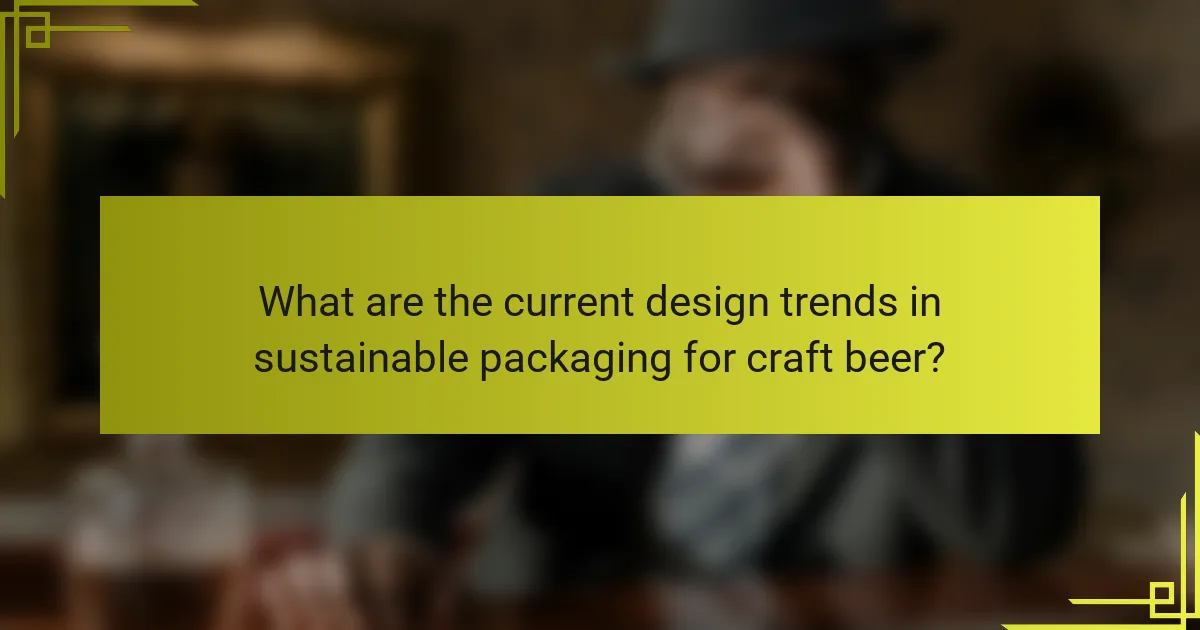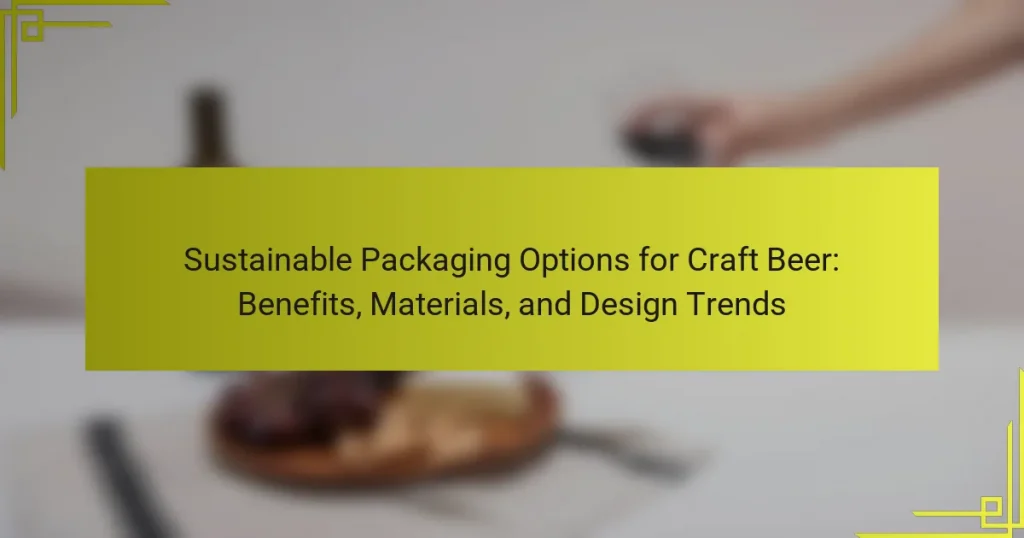Sustainable packaging options for craft beer focus on environmentally friendly materials such as biodegradable plastics, recycled paper, glass bottles, and aluminum cans. These materials not only reduce environmental impact but also enhance brand appeal and consumer loyalty. Key design trends in this sector include minimalist aesthetics and reusable containers, which align with the growing consumer preference for sustainable practices. A study by the Brewers Association indicates that a significant percentage of consumers favor brands that prioritize sustainability, driving innovation in packaging design within the craft beer industry.

What are Sustainable Packaging Options for Craft Beer?
Sustainable packaging options for craft beer include biodegradable materials, recycled paper, and glass bottles. These options reduce environmental impact and enhance brand appeal. Biodegradable materials break down naturally, minimizing waste. Recycled paper can be used for labels and packaging, conserving resources. Glass bottles are recyclable and can be reused multiple times, reducing the need for new materials. Additionally, aluminum cans are lightweight and highly recyclable, making them an eco-friendly choice. A study by the Brewers Association indicates that sustainable packaging can increase consumer loyalty and sales.
How do sustainable packaging options differ from traditional packaging?
Sustainable packaging options differ from traditional packaging primarily in their environmental impact. Sustainable packaging is designed to minimize waste and reduce carbon footprints. It often uses biodegradable, recyclable, or compostable materials. Traditional packaging typically relies on plastics and non-recyclable materials. According to the Ellen MacArthur Foundation, only 14% of plastic packaging is recycled globally. This stark contrast highlights the importance of sustainable practices. Sustainable packaging also emphasizes renewable resources, while traditional options often depend on fossil fuels. These differences reflect a broader commitment to sustainability in the craft beer industry.
What materials are commonly used in sustainable craft beer packaging?
Sustainable craft beer packaging commonly uses materials like recycled paper, glass, and aluminum. Recycled paper is often used for labels and boxes, minimizing waste. Glass bottles are recyclable and can be reused multiple times. Aluminum cans are lightweight and have a high recycling rate. Biodegradable materials, such as plant-based plastics, are also emerging. These materials reduce environmental impact and promote sustainability. Their use aligns with eco-friendly practices in the craft beer industry.
What are the environmental impacts of these sustainable materials?
Sustainable materials reduce environmental impacts significantly. They often require less energy during production compared to conventional materials. For instance, using recycled paper reduces carbon emissions by up to 60%. Biodegradable plastics break down more quickly, minimizing landfill waste. Additionally, sustainable materials often come from renewable resources, which decreases reliance on fossil fuels. This shift helps preserve natural ecosystems and biodiversity. Studies show that sustainable packaging can lower greenhouse gas emissions by 30% or more. Overall, these materials contribute to a circular economy, promoting waste reduction and resource efficiency.
Why is sustainable packaging important for the craft beer industry?
Sustainable packaging is important for the craft beer industry because it reduces environmental impact. The craft beer sector often emphasizes local sourcing and community values. Sustainable packaging aligns with these principles by minimizing waste and resource consumption. For example, using recyclable materials can decrease landfill contributions. A study by the Brewers Association found that 75% of craft breweries prioritize sustainability in their operations. Additionally, consumers increasingly prefer brands with eco-friendly practices. Research indicates that 60% of consumers are willing to pay more for sustainable products. Therefore, sustainable packaging not only supports environmental goals but also enhances brand loyalty and market competitiveness.
How does sustainable packaging contribute to reducing carbon footprints?
Sustainable packaging reduces carbon footprints by minimizing environmental impact during production and disposal. It often uses renewable materials, which require less energy to produce compared to traditional packaging. For example, plant-based plastics can lower greenhouse gas emissions by up to 68% compared to petroleum-based plastics. Sustainable packaging also promotes recycling and composting, reducing landfill waste. A study by the Ellen MacArthur Foundation found that circular economy practices, including sustainable packaging, could reduce global carbon emissions by 45% by 2030. Additionally, lighter packaging decreases transportation emissions, as less fuel is needed for shipping. Overall, sustainable packaging plays a crucial role in lowering carbon footprints across the supply chain.
What role does consumer demand play in the shift to sustainable packaging?
Consumer demand significantly influences the shift to sustainable packaging. As consumers increasingly prioritize environmental responsibility, brands respond by adopting eco-friendly packaging solutions. Research indicates that 72% of consumers prefer brands that use sustainable packaging. This demand drives companies to innovate and invest in materials that reduce environmental impact. Additionally, consumers are willing to pay a premium for products with sustainable packaging. This trend encourages manufacturers to align their practices with consumer preferences, fostering a market for sustainable options. Ultimately, consumer expectations shape industry standards and practices in packaging sustainability.
What benefits do sustainable packaging options offer to craft breweries?
Sustainable packaging options offer craft breweries numerous benefits. They enhance brand image by appealing to environmentally conscious consumers. A study found that 66% of consumers prefer brands with sustainable practices. Sustainable packaging reduces waste, contributing to lower environmental impact. This aligns with the growing demand for eco-friendly products. Additionally, using sustainable materials can lower production costs in the long term. Many sustainable options, such as recycled materials, are often cheaper than traditional packaging. Furthermore, sustainable practices can lead to regulatory advantages and tax incentives. These benefits position craft breweries favorably in a competitive market.
How can sustainable packaging enhance brand reputation?
Sustainable packaging can enhance brand reputation by demonstrating a commitment to environmental responsibility. Brands using eco-friendly materials attract environmentally conscious consumers. This can lead to increased customer loyalty and positive word-of-mouth. A study by Nielsen found that 66% of global consumers are willing to pay more for sustainable brands. Additionally, sustainable practices can differentiate a brand in a competitive market. Companies that prioritize sustainability often gain media attention, further boosting their visibility. Engaging in sustainable packaging can also improve overall brand image and trustworthiness.
What cost savings can breweries expect from adopting sustainable options?
Breweries can expect significant cost savings from adopting sustainable options. These savings primarily stem from reduced energy and water consumption. For example, using energy-efficient equipment can lower energy costs by up to 30%. Implementing water-saving technologies can cut water usage by 20-50%.
Additionally, sustainable packaging materials often reduce waste disposal costs. Breweries that switch to recyclable or biodegradable packaging can save on landfill fees. Furthermore, sustainable practices can enhance brand loyalty, leading to increased sales. According to a 2021 study by the Brewers Association, 70% of consumers prefer brands that demonstrate environmental responsibility.
Overall, the combination of reduced operational costs and increased consumer support can lead to substantial financial benefits for breweries.

What materials are used in sustainable packaging for craft beer?
Sustainable packaging for craft beer primarily utilizes materials like recycled paper, biodegradable plastics, and glass. Recycled paper is commonly used for cartons and labels, reducing waste and resource consumption. Biodegradable plastics, such as PLA (polylactic acid), are made from renewable resources and decompose more easily than traditional plastics. Glass is often recycled and can be reused multiple times, making it an eco-friendly option. Additionally, some craft breweries use aluminum cans, which are lightweight and highly recyclable. These materials collectively contribute to reducing the environmental impact of packaging in the craft beer industry.
What are the most popular sustainable materials for craft beer packaging?
The most popular sustainable materials for craft beer packaging include recycled cardboard, glass, and biodegradable plastics. Recycled cardboard is widely used for boxes and six-pack carriers. It reduces waste and is easily recyclable. Glass bottles are favored for their recyclability and ability to preserve flavor. Many breweries use lightweight glass to minimize transportation emissions. Biodegradable plastics, such as PLA, are emerging for single-use items. These materials break down more quickly than traditional plastics. Each of these options contributes to reducing the environmental impact of packaging in the craft beer industry.
How do biodegradable materials perform compared to traditional options?
Biodegradable materials generally perform better in environmental sustainability compared to traditional options. They decompose more quickly in natural conditions, reducing landfill waste. Traditional materials, such as plastics, can take hundreds of years to break down. Biodegradable materials are often made from renewable resources, contributing to a lower carbon footprint. Research indicates that biodegradable plastics can reduce greenhouse gas emissions by up to 68% compared to conventional plastics. Additionally, biodegradable options can enhance brand image in eco-conscious markets. However, performance in durability and shelf life can vary, sometimes requiring careful selection for specific applications.
What are the advantages of using recycled materials in packaging?
Using recycled materials in packaging reduces environmental impact and promotes sustainability. It decreases the need for virgin resources, conserving natural habitats. Recycling materials requires less energy compared to producing new materials. This process results in lower greenhouse gas emissions. According to the EPA, recycling one ton of paper can save 17 trees. Recycled packaging often has a lower carbon footprint. It can enhance brand image by appealing to eco-conscious consumers. Additionally, using recycled materials can lead to cost savings in production.
How do different materials impact the shelf life of craft beer?
Different materials significantly impact the shelf life of craft beer. Glass bottles provide an effective barrier against oxygen and light, preserving flavor and carbonation. Aluminum cans are also excellent, as they prevent light exposure and are airtight. Plastic bottles, however, allow more oxygen permeation, which can lead to quicker spoilage. The thickness of the material also plays a role; thicker glass offers better protection than thinner options. Research indicates that beer stored in cans can remain fresh for up to a year, while bottled beer may last six months. Proper sealing techniques enhance the longevity of all types of packaging.
What are the effects of packaging material on beer flavor and quality?
Packaging material significantly affects beer flavor and quality. Different materials, such as glass, aluminum, and plastic, interact with beer in unique ways. Glass bottles provide an airtight seal, preventing oxidation and preserving flavor. Aluminum cans block light, which protects beer from light-struck off-flavors. Plastic can allow oxygen permeation, leading to stale flavors over time. The choice of packaging material can influence shelf life and taste stability. Studies show that beer packaged in cans retains its freshness longer than beer in bottles. The material’s interaction with beer compounds can alter aroma and mouthfeel. Therefore, selecting the right packaging is crucial for maintaining beer’s intended flavor profile and overall quality.
How do breweries ensure compatibility between beer and packaging materials?
Breweries ensure compatibility between beer and packaging materials through careful selection and testing. They analyze the chemical properties of both the beer and the packaging. This analysis helps to identify any potential interactions that could affect flavor or quality. Breweries often use materials that are inert and do not react with the beer. Common materials include glass, aluminum, and certain plastics. They also conduct shelf-life studies to monitor any changes over time. These studies help confirm that the packaging maintains the beer’s integrity. Additionally, breweries may collaborate with packaging suppliers to ensure optimal compatibility.

What are the current design trends in sustainable packaging for craft beer?
Current design trends in sustainable packaging for craft beer include the use of biodegradable materials, minimalist designs, and reusable containers. Biodegradable materials, such as plant-based plastics, reduce environmental impact. Minimalist designs emphasize eco-friendliness and brand identity. Reusable containers promote sustainability by encouraging customers to return for refills. These trends reflect a growing consumer preference for environmentally responsible products. According to a 2021 survey by the Brewers Association, 70% of consumers prefer brands with sustainable practices. This shift is driving innovation in packaging design within the craft beer industry.
How are breweries incorporating eco-friendly design into their packaging?
Breweries are incorporating eco-friendly design into their packaging by using sustainable materials. Many breweries opt for recyclable or biodegradable materials such as glass, aluminum, and plant-based plastics. They are also reducing packaging waste by utilizing minimalist designs and fewer layers of materials. Some breweries are implementing refillable bottle systems to minimize single-use packaging. Additionally, eco-friendly inks and adhesives are being used to further reduce environmental impact. According to a 2021 survey by the Brewers Association, 60% of breweries reported using sustainable packaging practices. This shift not only benefits the environment but also appeals to environmentally conscious consumers.
What innovative designs are emerging in the sustainable packaging landscape?
Innovative designs in the sustainable packaging landscape include biodegradable materials and reusable containers. Biodegradable packaging is made from natural substances that decompose more quickly than traditional materials. This reduces landfill waste significantly. Reusable containers, such as glass growlers, promote a circular economy by encouraging consumers to return them for refills.
Additionally, packaging made from recycled materials is gaining traction. This approach minimizes the need for virgin resources and lowers carbon footprints. Edible packaging is also emerging, allowing consumers to consume the packaging itself, further reducing waste.
Another innovation is smart packaging, which incorporates technology to enhance product freshness and track sustainability metrics. These designs not only address environmental concerns but also align with consumer preferences for eco-friendly products. The continuous evolution in sustainable packaging reflects a growing commitment to environmental stewardship in various industries, including craft beer.
How does packaging design influence consumer perception of sustainability?
Packaging design significantly influences consumer perception of sustainability. Attractive and eco-friendly packaging can enhance the perceived value of a product. Consumers often associate minimalist designs with sustainability. Colors and materials also play a crucial role in signaling eco-friendliness. For instance, earthy tones and recycled materials can convey a commitment to the environment. Research shows that 67% of consumers consider packaging sustainability in their purchasing decisions. Brands that prioritize sustainable packaging often experience increased customer loyalty. Effective communication of sustainability efforts through packaging can lead to positive brand associations.
What challenges do breweries face when implementing sustainable packaging designs?
Breweries face several challenges when implementing sustainable packaging designs. One significant challenge is the higher cost of sustainable materials compared to traditional packaging. This can impact profit margins, especially for small breweries. Another challenge is the availability and sourcing of eco-friendly materials. Not all suppliers offer sustainable options, which can limit choices. Additionally, breweries may encounter technical difficulties in adapting production lines for new materials. This can lead to increased downtime and operational costs. Consumer awareness and demand for sustainable packaging can also vary. Some customers may prioritize price over sustainability, complicating marketing efforts. Lastly, regulatory compliance regarding packaging materials can pose challenges. Breweries must navigate varying regulations across different regions. These factors collectively hinder the seamless transition to sustainable packaging in the brewing industry.
How can breweries overcome barriers to adopting sustainable packaging solutions?
Breweries can overcome barriers to adopting sustainable packaging solutions by investing in research and development. This investment helps identify innovative materials that are both sustainable and cost-effective. Collaborating with suppliers can streamline access to eco-friendly packaging options. Education and training for staff can increase awareness of sustainability practices. Implementing a phased approach allows breweries to gradually transition to sustainable packaging. Financial incentives and government grants can ease the initial costs of switching. Consumer demand for sustainability can drive breweries to adopt these solutions. According to a 2021 Nielsen report, 73% of consumers are willing to pay more for sustainable products, highlighting market potential.
What are the best practices for adopting sustainable packaging in craft beer?
The best practices for adopting sustainable packaging in craft beer include using recyclable materials, minimizing packaging weight, and implementing refillable systems. Craft breweries should prioritize materials such as aluminum and glass, which are highly recyclable. They can also explore biodegradable options like plant-based plastics. Reducing the weight of packaging lowers transportation emissions. Implementing a refillable system encourages customers to return containers for reuse. Additionally, breweries can collaborate with suppliers who prioritize sustainability. Adopting these practices not only reduces environmental impact but can also enhance brand reputation among eco-conscious consumers.
Sustainable packaging options for craft beer focus on environmentally friendly materials such as biodegradable plastics, recycled paper, glass, and aluminum. These materials significantly reduce waste and carbon footprints compared to traditional packaging, which often relies on non-recyclable plastics. The article explores the benefits of sustainable packaging, including enhanced brand reputation, cost savings, and increased consumer loyalty, as well as current design trends that reflect a growing commitment to sustainability in the craft beer industry. Additionally, it addresses the challenges breweries face in adopting these solutions and outlines best practices for effective implementation.




